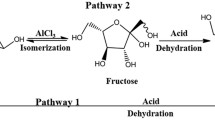Abstract
Cassava residue was proposed as a raw material for the production of ethylene glycol (EG) via a one-pot hydrothermal reaction in the present study. Various mixed catalysts consisting of activated carbon supported Ru (Ru/AC) and a tungsten species were used for the conversion of cassava residues, and the effects of various reaction conditions on the catalytic performance were investigated. When the reaction was carried out at 245 °C for 60 min, the Ru/AC–H2WO4 mixed catalyst showed a EG yield of 53.1 % with a total polyols yield of 80 %, which was confirmed to be the most active among the prepared catalysts. The excellent catalytic performance using cassava residue as the feedstock mainly resulted from a high content of carbohydrates and a low amount of lignin in cassava residues. Furthermore, the Ru/AC–H2WO4 catalyst also showed reasonable stability during the hydrothermal conversion of cassava residues for EG production.






Similar content being viewed by others
References
Yue, H., Zhao, Y., Ma, X., Gong, J.: Ethylene glycol: properties, synthesis, and applications. Chem. Soc. Rev. 41, 4218–4244 (2012)
Wang, A., Zhang, T.: One-pot conversion of cellulose to ethylene glycol with multifunctional tungsten-based catalysts. Acc. Chem. Res. 46, 1377–1386 (2013)
Celik, F.E., Lawrence, H., Bell, A.T.: Synthesis of precursors to ethylene glycol from formaldehyde and methyl formate catalyzed by heteropoly acids. J. Mol. Catal. A: Chem. 288, 87–96 (2008)
Ji, N., Zhang, T., Zheng, M., Wang, A., Wang, H., Wang, X., Chen, J.G.: Direct catalytic conversion of cellulose into ethylene glycol using nickel-promoted tungsten carbide catalysts. Angew. Chem. Int. Ed. 47, 8510–8513 (2008)
Zheng, M., Pang, J., Wang, A., Zhang, T.: One-pot catalytic conversion of cellulose to ethylene glycol and other chemicals: from fundamental discovery to potential commercialization. Chin. J. Catal. 35, 602–613 (2014)
Li, C., Zheng, M., Wang, A., Zhang, T.: One-pot catalytic hydrocracking of raw woody biomass into chemicals over supported carbide catalysts: simultaneous conversion of cellulose, hemicellulose and lignin. Energy Environ. Sci. 5, 6383–6390 (2012)
Zheng, M., Wang, A., Ji, N., Pang, J., Wang, X., Zhang, T.: Transition metal-tungsten bimetallic catalysts for the conversion of cellulose to ethylene glycol. ChemSusChem 10, 63–66 (2010)
Tai, Z., Zhang, J., Wang, A., Pang, J., Zheng, M., Zhang, T.: Catalytic conversion of cellulose to ethylene glycol over a low-cost mixed catalyst of Raney Ni and Tungstic acid. ChemSusChem 6, 652–658 (2013)
Tai, Z., Zhang, J., Wang, A., Zheng, M., Zhang, T.: Temperature- controlled phase-transfer catalysis for ethylene glycol production from cellulose. Chem. Commun. 48, 7052–7054 (2012)
Liu, Y., Luo, C., Liu, H.: Tungsten trioxide promoted selective conversion of cellulose into propylene glycol and ethylene glycol on a ruthenium catalyst. Angew. Chem. Int. Ed. 51, 3249–3253 (2012)
Yang, Y., Zhang, W., Yang, F., Brown, D.E., Ren, Y., Lee, S., Zeng, D., Gao, Q., Zhang, X.: Versatile nickel-tungsten bimetallics/carbon nanofiber catalysts for direct conversion of cellulose to ethylene glycol. Green Chem. 18, 3949–3955 (2016)
Liu, H., Wang, X., Du, C., Sun, D., Meng, X.: Hydrolytic hydro-conversion of cellulose to ethylene glycol over bimetallic CNTs-supported NiWB amorphous alloy catalyst. Catal. Commun. 77, 47–51 (2016)
Sun, R., Wang, T., Zheng, M., Deng, W., Pang, J., Wang, A., Wang, X., Zhang, T.: Versatile Nickel–Lanthanum (III) catalyst for direct conversion of cellulose to glycols. ACS Catal. 5, 874–883 (2015)
Pang, J., Zheng, M., Sun, R., Song, L., Wang, A., Wang, X., Zhang, T.: Catalytic conversion of cellulosic biomass to ethylene glycol: effects of inorganic impurities in biomass. Bioresour. Technol. 175, 424–429 (2015)
Pang, J., Zheng, M., Wang, A., Zhang, T.: Catalytic hydrogenation of corn stalk to ethylene glycol and 1,2-propylene glycol. Ind. Eng. Chem. Res. 50, 6601–6608 (2011)
Miao, G., Wang, C.C., Wang, J.J., Tan, Z.C., Wang, L., Liu, J.L., Kong, L.Z., Sun, Y.H.: Efficient one-pot production of 1,2-propanediol and ethylene glycol from microalgae (Chlorococcum sp.) in water. Green Chem. 17, 2538–2544 (2015)
Fabičovicová, K., Lucas, M., Claus, P.: From microcrystalline cellulose to hard- and softwood-based feedstocks: their hydrogenolysis to polyols over a highly efficient ruthenium-tungsten catalyst. Green Chem. 17, 3075–3083 (2015)
Pang, J., Zheng, M., Wang, A., Sun, R., Wang, H., Jiang, Y., Zhang, T.: Catalytic conversion of concentrated miscanthus in water for ethylene glycol production. AIChE J. 60, 2254–2262 (2014)
Zhou, L., Pang, J., Wang, A., Zhang, T.: Catalytic conversion of Jerusalem artichoke to ethylene glycol over a combined catalyst of WO3 and Raney Ni. Chin. J. Catal. 2013, 2041–2046 (2013)
Pattiya, A., Suttibak, S.: Production of bio-oil via fast pyrolysis of agricultural residues from cassava plantations in a fluidised-bed reactor with a hot vapour filtration unit. J. Anal. Appl. Pyrol. 95, 227–235 (2012)
Van Soest, P.J.: Use of detergents in the analysis of fibrous feeds. II. A rapid method for the determination of fiber and lignin. J. Assoc. Off. Anal. Chem. 46, 829–835 (1963)
Kataoka, Y., Kondo, T.: FT-IR microscopic analysis of changing cellulose crystalline structure during wood cell wall formation. Macromolecules 31, 760–764 (1998)
Acknowledgments
This work was supported by the Science and Technology Project of Guangzhou City (No. 201607020025), the National Basic Research Program of China (No. 2013CB228101), the Fundamental Research Funds for the Central Universities (No. 2015ZZ136), and the State Key Laboratory of Pulp and Paper Engineering (No. 2015QN02).
Author information
Authors and Affiliations
Corresponding authors
Rights and permissions
About this article
Cite this article
Zhang, K., Wu, S., Yang, H. et al. Catalytic Conversion of Cassava Residues to Ethylene Glycol Via a One-Pot Hydrothermal Reaction. Waste Biomass Valor 8, 2443–2450 (2017). https://doi.org/10.1007/s12649-016-9706-y
Received:
Accepted:
Published:
Issue Date:
DOI: https://doi.org/10.1007/s12649-016-9706-y




